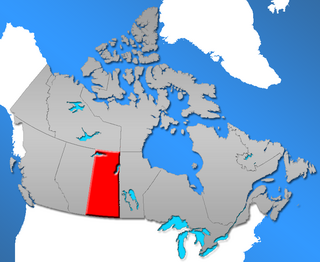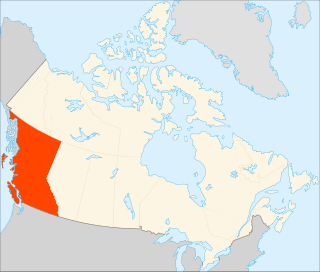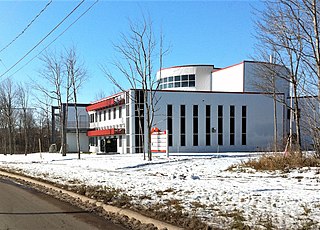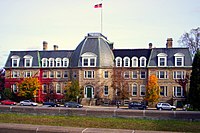
Crandall University is a Baptist Christian liberal arts university located in Moncton, New Brunswick, Canada. It is affiliated with the Canadian Baptists of Atlantic Canada.

Mount Allison University is a Canadian primarily undergraduate liberal arts university located in Sackville, New Brunswick, founded in 1839.

St. Thomas University is a Catholic, English-language liberal arts university located in Fredericton, New Brunswick, Canada. It is a primarily undergraduate university offering bachelor's degrees in the arts, education, and social work to approximately 1,900 students. The average class size is 30 and no class is larger than 60.

Education in Canada is for the most part provided publicly, funded and overseen by federal, provincial, and local governments. Education is within provincial jurisdiction and the curriculum is overseen by the province. Education in Canada is generally divided into primary education, followed by secondary education and post-secondary. Education in both English and French is available in most places across Canada. Canada has a large number of universities, almost all of which are publicly funded. Established in 1663, Université Laval is the oldest post-secondary institution in Canada. The largest university is the University of Toronto with over 85,000 students. Four universities are regularly ranked among the top 100 world-wide, namely University of Toronto, University of British Columbia, McGill University, and McMaster University, with a total of 18 universities ranked in the top 500 worldwide.
New Brunswick Community College (NBCC) is a public college located throughout various locations in New Brunswick, Canada, including Moncton, Miramichi, Fredericton, Saint John, St. Andrews, and Woodstock.
The New Brunswick Student Alliance is a student driven organization that advocates for more than 12,000 post-secondary students across New Brunswick.

The Moncton Flight College (MFC) is a pilot training school based at the Greater Moncton International Airport (CYQM) in Dieppe, New Brunswick, Canada. They have a second location at the Fredericton International Airport (YFC) in Lincoln, NB. In a year, MFC has the capacity to train 450 students between the Moncton and Fredericton Campus. Currently the Moncton Campus offers domestic and international programs with a 260-student capacity and a staff of 55. The Fredericton campus is primarily for Chinese student training with some modular based flight training and has a capacity of 190 students and employs 70 people. Both of the campuses have on-site kitchens and residences. MFC is the largest private flight school in Canada. It is also one of six, out of 150 schools in Canada, to be given integrated status. The college has trained over 20,000 pilots from approximately 70 countries since 1929. MFC has an approved FTU, ATO and AMO from Transport Canada and also has CAAC (China) approval.
The Maritime College of Forest Technology is a Canadian post-secondary college with campuses located in Fredericton, New Brunswick and Bathurst, New Brunswick.

Higher education in Ontario includes postsecondary education and skills training regulated by the Ministry of Colleges and Universities and provided by universities, colleges of applied arts and technology, and private career colleges. The current minister is Jill Dunlop who was appointed in June 2021. The ministry administers laws covering 22 public universities, 24 public colleges, 17 privately funded religious universities, and over 500 private career colleges. 18 of the top 50 research universities in Canada are in Ontario.

Higher education in Canada includes provincial, territorial, Indigenous and military higher education systems. The ideal objective of Canadian higher education is to offer every Canadian the opportunity to acquire the skills and knowledge necessary to realize their utmost potential. It aspires to cultivate a world-class workforce, enhance the employment rate of Canadians, and safeguard Canada's enduring prosperity. Higher education programs are intricately designed with the perspective of the learner in focus, striving to mitigate risks and assure definite outcomes.

Newfoundland and Labrador has had the same growing pains as other provinces in developing its own form of education and now boasts a very strong, although relatively small, system. The direction of Newfoundland and Labrador's policy has evolved rapidly since the late 1990s, with increased funding, participation rates, accessibility and transferability. Many of the directives the government has been acting upon in the past 10 years have been a result of recommendations that stemmed from a 2005 white paper: Foundation for Success: White Paper on Public Post-Secondary Education. It set the course for furthering the strategic directives of the provincial post-secondary education sector. Some of its recommendations aimed to:
Higher education in Manitoba includes institutions and systems of higher or advanced education in the province of Manitoba.

Historically, Saskatchewan's higher education system has been "significantly shaped" by demographics. In 1901, six years prior to the 1907 founding of a university in Saskatchewan, the urban population in Saskatchewan was 14,266 (16%) while the rural population was 77,013 (84%). One hundred years later, the proportions had changed significantly: urban population in 2001 was 629,036 (64%) while the rural population was 349,897 (36%). Over time the province's higher education system has changed significantly in response both to this demographic shift and to provincial politics.

Higher education in Alberta refers to the post secondary education system for the province of Alberta. The Ministry of Advanced Education in Alberta oversees educational delivery through universities, publicly funded colleges, technical institutions, and private colleges. These institutions offer a variety of academic and vocational pursuits. Students have access to post-secondary options through most regions of Alberta, and a developed articulation system allows for increased student mobility.

Higher education in Prince Edward Island refers to education provided by higher education institutions in the Canadian province of Prince Edward Island. In Canada, education is the responsibility of the provinces and there is no Canadian federal ministry governing education. Prince Edward Island has two post-secondary institutions authorized to grant degrees: one university, the University of Prince Edward Island, and one college, Maritime Christian College. There are also two community colleges: Holland College, which operates centres across the province, and Collège de l'Île, which offers post secondary education in French. The governing body for higher education in Prince Edward Island is the Department of Innovation and Advanced Learning, headed by the Minister of Innovation and Advanced Learning, the Honourable Allen Roach.

Higher education in Nova Scotia refers to education provided by higher education institutions. In Canada, education is the responsibility of the provinces and there is no Canadian federal ministry governing education. Nova Scotia has a population of one million people, but is home to ten public universities and the Nova Scotia Community College, which offers programs at 13 locations.

Higher education in British Columbia is delivered by 25 publicly funded institutions that are composed of eleven universities, eleven colleges, and three institutes. This is in addition to three private universities, five private colleges, and six theological colleges. There are also an extensive number of private career institutes and colleges. Over 297,000 students were enrolled in post-secondary institutions in British Columbia in the 2019-2020 academic year.

The Department of Post-Secondary Education, Training and Labour is a department in the Government of New Brunswick responsible for "ensuring the New Brunswick workforce is competitive by making strategic investments in people through innovative programs, services and partnerships." The Department oversees the province's public universities and colleges, the provincial student loan system, public libraries, labour, adult learning and literacy, as well as immigration. There are a number of Acts under the Department's legislative purview, including New Brunswick's Employment Standards Act, Workers' Compensation Act and Human Rights Act. Several arms-length agencies and Crown corporations report to the Legislative Assembly of New Brunswick through the Minister responsible for the Department, such as the Labour and Employment Board, the Human Rights Commission, WorkSafeNB and New Brunswick's community colleges.

The Centre de formation médicale du Nouveau-Brunswick (CFMNB) is a joint campus of Université de Sherbrooke in Moncton, New Brunswick, Canada.


















